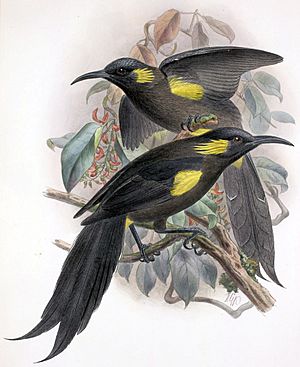Bishop's ʻōʻō facts for kids
Quick facts for kids Bishop's ‘ō‘ō |
|
|---|---|
 |
|
| Specimen in Bishop Museum, Honolulu | |
| Conservation status | |
| Scientific classification | |
| Genus: |
Moho
|
| Species: |
bishopi
|
| Synonyms | |
|
|
The Bishop's ‘ō‘ō (pronounced oh-oh), also known as the Molokai ‘ō‘ō, was a special type of bird that is now extinct. It belonged to a group of birds called ‘ō‘ōs, which were all part of the extinct family Mohoidae. Scientists used to think it was related to honeyeaters, but now they know it was unique. A famous bird collector, Lionel Walter Rothschild, named this bird after Charles Reed Bishop, who started the Bishop Museum.
Contents
What it Looked Like
This bird was first found in 1892 by Henry C. Palmer, who collected birds for Lord Rothschild. It was about 29 centimeters (about 11 inches) long, which is roughly the length of a ruler. Its tail alone was about 10 centimeters (4 inches) long.
The Bishop's ‘ō‘ō had shiny black feathers all over its body. It also had bright yellow feathers under its wings and near its tail. Its song was quite simple, just two notes that sounded like took-took. People could hear these calls from far away!
Where it Lived
The Bishop's ‘ō‘ō lived only in a specific part of the world. It was an endemic bird, meaning it was found nowhere else. It lived in the high-up forests on the eastern side of the Hawaiian island of Molokai, especially around Mount Olokai.
Scientists have also found old bones of similar birds on the island of Maui. These bones were found on Mount Olinda, high up in the mountains. Some people think these might have been a different kind of ‘ō‘ō, sometimes called the Maui ʻōʻō.
What it Ate
We don't know a lot about the daily life of the Bishop's ‘ō‘ō. However, we do know that it was a nectarivore. This means it mostly ate nectar, which is the sweet liquid found in flowers. It got its food from the flowers of Hawaiian lobelioids, which are a group of plants native to Hawaii.
Why it Disappeared
Sadly, the Bishop's ‘ō‘ō is now extinct, meaning there are no more of these birds left alive. Several things led to its disappearance:
- Loss of Forests: People cut down many trees in the forests where these birds lived. This took away their homes and food sources.
- New Animals: Animals like rats, pigs, and mongooses were brought to Hawaii. These animals hunted the birds and ate their eggs.
- Hunting: Ancient Hawaiians sometimes hunted these birds for their beautiful yellow feathers. These feathers were very valuable and were used to make special capes for Hawaiian royalty.
- Diseases: New diseases, carried by mosquitoes, also spread among the birds. The birds had no natural protection against these new illnesses.
The last time anyone definitely saw a Bishop's ‘ō‘ō was in 1904. An ornithologist (a bird scientist) named George Campbell Munro saw it then. He tried to find it again in 1915 but couldn't. There was a possible sighting in 1981 on Maui, but this was never officially confirmed.
Where to See it Now
Today, you can only see the Bishop's ‘ō‘ō in museums. Scientists keep specimens (preserved bodies) of the birds. You can also see them in paintings, old notes, and as bird skins. These valuable records are kept in places like Honolulu, London, New York, and Stockholm, helping us remember this unique Hawaiian bird.
See also
 In Spanish: Moho bishopi para niños
In Spanish: Moho bishopi para niños



